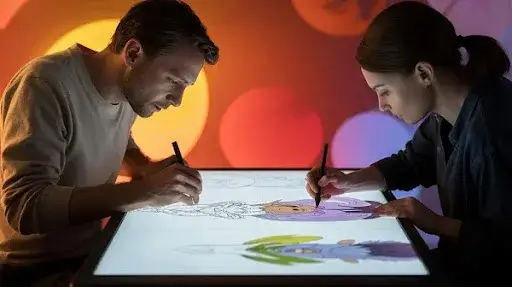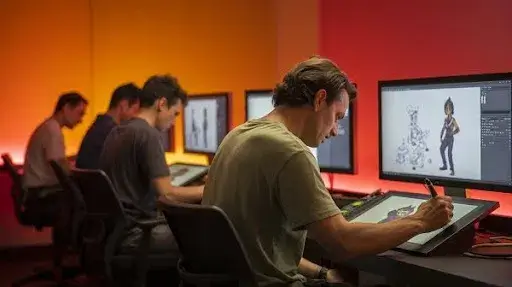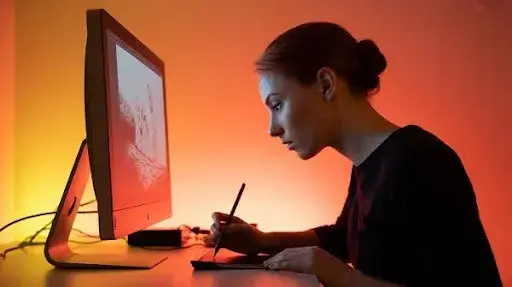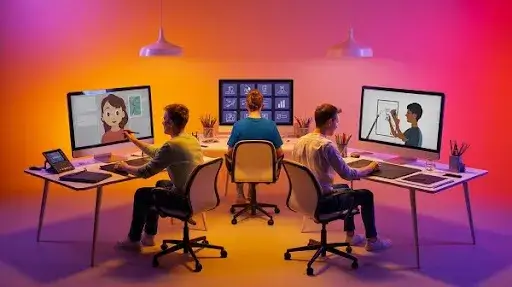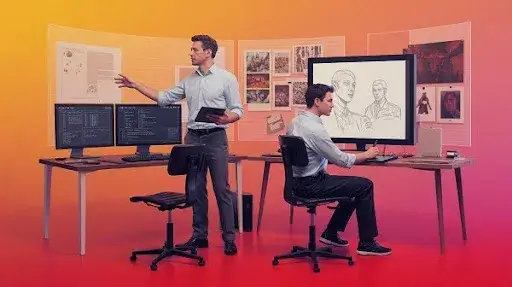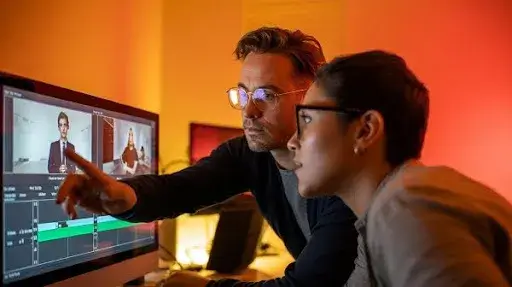People made marks long before they called them “art.” A stick, ochre, a wall. That first urge to show something is still here; now it lives in comics, app icons, indie game sprites, and ad illustrations. It’s flat. Quick. Gets a point across fast.
Not only painters use 2D art. Animators, UI people, small studios, marketers, they all use it. Knowing 2D art helps you get ideas out fast, without overexplaining.
What is 2D Art? Meaning and Definition
Two dimensions. Height and width. No physical depth. That’s it. This is the simple split between 2D art vs 3D art. 3D tries to copy space. 2D says: Let’s stay on the plane and still be strong.
When someone asks what is 2D art, you can say it’s drawings, paintings, murals, pixel art, vector art, storyboards, or anything on a flat surface. Traditional 2D art covers paper, canvas, and paint. Digital 2D art is the stuff done in Procreate, Photoshop, Clip Studio, and Illustrator. Same building blocks: line, shape, color, composition.
The meaning? It explains. It sells. It tells. You don’t need extra dimensions to hit a feeling.
A Very Short History
Cave walls. Simple figures. People record hunts, seasons, and ideas. That’s our oldest 2D art examples.
Then pottery drawings. Wall paintings in tombs. Tapestries that were pretty much comics stitched in thread. Fast forward: Renaissance artists pushed drawing and painting hard; da Vinci, Michelangelo taught us how flat marks can read as life.
Now? Tablets and styluses. Same motives, swapped tools. History of 2D art is not dead, it’s just using new pens.
Types of 2D Art and Styles
There are many 2D art styles. Some focus on lines. Some live in color. Some lean on texture. Pick what fits your goal.
Drawing
Start here. Pencil, ink, digital stylus. 2D drawing can be tight or messy. It’s the sketch that becomes a character or the thumbnail that becomes a whole scene.
Painting
Add tone. Add surface. Watercolor, oil, acrylic, or a digital brush. Painting makes light feel present, even on a flat picture. Old masters did it for atmosphere. Modern artists use software and don’t worry about drying time.
Wall Art and Murals
Big surfaces. Public eyes. Street art and murals grab attention and speak quickly. This is a 2D visual design that meets the public, not just galleries.
Digital 2D Art
This changed speed and scale. Layers, undo, pressure sensitivity, and tools that let artists iterate fast. Studios offering professional 2D animation services now use this workflow: sketch, clean, color, and animate.
Elements and Principles of 2D Art: The Nuts and Bolts
Good 2D artwork techniques use a handful of tools. Learn these, and your work stops looking accidental.
Lines. They give direction. They carve shapes. In 2D character design, lines map movement and attitude.
Shapes. Break stuff into circles, boxes, and triangles. Combine them and you get bodies, props, and architecture.
Color. This is the mood maker. Bright palettes shout. Muted palettes whisper. In 2D environment art, color tells you where to look first.
Texture and Space. Flat doesn’t mean boring. Texture hints at surface. Negative space gives room to breathe.
Principles like balance, contrast, emphasis, rhythm, and unity glue the elements together. With them, your 2D concept art reads. Without them, it looks like a messy sketch.
Why 2D Art Still Matters
It’s cheap to make. Fast to iterate. It talks clearly. That’s why brands, indie devs, book publishers, and studios still rely on it.
Communication. A quick illustration can explain what a page of text never will.
Style. 2D gives identity. A logo, a mascot, a set of icons, they create recognition.
Speed. Need a thumbnail? A banner? A short promo? 2D art gets it done without rendering farms.
Where You See 2D Art Daily
You see it more than you think.
Comics and Illustration. Panels, story beats, cover art. That’s classic 2D at work.
2D Art in Animation. Before a character moves, it’s drawn. Storyboards, key frames, color guides, they’re all flat first.
Games and Interactive Media. Mobile and indie games still use 2D art for games heavily: sprites, tiles, UI, and backgrounds. Even big titles use 2D for concept and UI.
Ads and Marketing. Brands use illustrated assets, short loops, and infographic visuals to tell quick stories. 2D holds attention on small screens.
2D Art in Digital Media and Entertainment
Most people don’t even notice how much 2D art holds up digital media. It’s not just cartoons and comics anymore. Scroll through your phone and count how many things are flat visuals: app icons, stickers, motion graphics, thumbnails, UI elements, posters, and menu screens. All of that is 2D work.
Studios that build games, explainer videos, YouTube animations, and streaming ads use digital 2D art as their base. Someone draws it first, then teams shape it into motion or layout.
2D Art in Entertainment
Movies, animated shorts, title cards, and credit sequences all pull from traditional 2D art, even if the final result is mixed with 3D or live footage. Think of how anime still runs on 2D character design before any movement happens. Western studios do the same for storyboards and concept layouts.
Professional 2D animation services don’t just animate. They handle character sheets, environment mockups, typography, backgrounds, props, and facial expression charts, all sitting on a flat canvas before motion gets added.
2D Art for Games
Games rely heavily on it. Even projects that use 3D engines still need 2D concept art to build the world. Someone sketches the character, then a 3D artist models it. Menus, maps, icons, cutscene stills, achievement badges, all 2D.
Some devs skip 3D completely and stick with pixel art, vector rigs, or frame-by-frame animation. It’s cheaper, faster, and gives a style that doesn’t age as quickly. Look at indie titles, mobile games, and visual novels, you’ll see 2D art carrying the load.
The Uses and Importance of 2D Art
People like to think 2D art is “basic” because there’s no modeling involved. That’s wrong. It works in more industries than most people realize.
Communication and Education
Schools use it to build illustrations for worksheets, textbooks, and educational apps. Diagrams, maps, and step-by-step visuals, easier to understand than a chunk of text. Instruction manuals, packaging icons, safety signs, and still flat drawings do the job.
Branding and Identity
Brands use 2D visual design to feel recognizable. Mascots, logo variations, illustrated ads, icon sets, digital stickers, all rooted in simple 2D art styles. Even luxury brands use hand-drawn elements now to look “less staged” and more personal.
Social Media and Advertising
Scroll Instagram, LinkedIn, TikTok ads, and half the stuff you see is 2D artwork. Motion graphics, looping GIFs, illustrated reels, covers, minimal vector portraits, it sells products without heavy text.
The importance of 2D art is that it gets attention fast without needing giant budgets or dramatic renders.
Careers and Fields That Use 2D Art
If someone thinks only painters and cartoonists use it, they haven’t looked around lately.
Artists and Illustrators
Obvious one. Comic artists, children’s book illustrators, editorial illustrators, concept artists, they all live in that space. Independent creators sell prints and assets online using digital 2D art.
Animators
Even if the final work is 3D, animators still plan with 2D boards, character poses, and visual references. Walk cycles, gesture sheets, and facial breakdowns all start flat.
Studios that offer professional 2D animation services build pipelines around digital art apps. From rough thumbnails to final renders, flat work guides the process.
Game Artists
Character designers, environment artists, UI designers, and concept artists for games need 2D drawing and painting skills. They mock up levels, icons, skins, weapons, and scenes before anyone touches a modeling app.
Designers and Marketers
Graphic designers use 2D artwork techniques every day. Posters, brochures, ads, packaging, merch designs, all flat visuals. Marketing teams build visual campaigns with illustrations, infographics, and UI mockups.
Freelancers and Indie Creators
People build side income with custom 2D art: Twitch emotes, brand mascots, avatar portraits, printable posters, Spotify canvas loops, album covers. Social platforms made it easy to sell.
Modern 2D Art: Software and Tools
Tools changed, but the approach didn’t. Instead of chalk and canvas, artists jump into apps and tablets.
Popular 2D Art Software
Photoshop, Procreate, Clip Studio, Illustrator, Krita, Sketchbook, these are the main ones. Some artists use After Effects for light animation or rough comps. Others use Toon Boom Harmony or TVPaint for full professional pipelines.
The goal is the same: sketch, refine, color, export. Brushes replace actual bristles, but the fundamentals don’t disappear.
Tablets and Styluses
iPads, display tablets, Wacom screens, they let artists keep the hand feel of drawing while staying digital. Layers and undo make experiments less stressful compared to traditional 2D art with wet paint or ink spills.
2D Art vs 3D Art
Some people act like one is better, but it’s not a fight. They just serve different needs.
3D builds shapes with depth, lighting, and angles. Great for realism, product design, VR, or detailed animation.
2D is faster for storytelling, quicker to revise, easier for stylized ideas, and cheaper for teams with limited budgets. It lands better on phones and print too.
A lot of studios mix both. Concept art is drawn in 2D, then passed to 3D artists. UI and textures for 3D games are done in 2D first. Even animated films with 3D models use 2D art for reference.
Portfolio and Inspiration
If someone wants to work in this space, they need a 2D art portfolio. Doesn’t need to be fancy, just clean files that show range. Character sheets, background samples, props, environment art, UI mockups, color scripts.
Finding 2D art inspiration isn’t hard. People look at Pinterest boards, art books, game art dumps, Behance, ArtStation, Instagram accounts, zines, even old posters.
The trick isn’t copying, it’s understanding styles, studying what works, then building something fresh.
Techniques and Workflow
No one makes good art by accident. Even loose styles follow some structure.
Some artists start with gesture sketches before refining. Others block colors first, then carve shapes with line. Some use a single brush, some mix textures.
2D artwork techniques differ, but most use similar steps: rough idea, shape breakdown, cleaned lines, color, shading, polish. Then export.
People working in animation create model sheets, turnaround poses, expression charts, story frames, and environment layouts. Each piece is part of a bigger plan.
Frequently Asked Questions
Is 2D art still used in animation today?
Yes. Every animated project starts in 2D. Storyboards, character poses, scene planning, all drawn flat before motion enters the picture.
Does digital 2D art replace traditional drawing?
No. Digital tools speed things up, but don’t erase sketchbooks or paint. Some artists switch between both depending on the project.
Is 2D art easier than 3D?
It depends. 2D skips modeling and rigging but still needs strong drawing and composition skills. It’s faster for some things and harder for others.
What jobs use 2D art?
Illustration, animation, marketing, publishing, gaming, branding, web design. Even architects and UI designers sketch in 2D.
Can someone start a career with only 2D skills?
Yes. Many artists work full-time or freelance without touching 3D at all. A solid portfolio matters more than software lists.
Final Words
If someone needs content that explains fast, builds identity, or sells an idea without overproduced fluff, 2D art still delivers. It works for ads, games, animations, learning material, product launches, and anything that needs to stick in a viewer’s head.
Studios that understand 2D art don’t just draw. They translate ideas into visuals that speak without long descriptions. If you’re planning a campaign, animation, or design project, getting the right team behind the artwork makes all the difference.
When you’re ready to build characters, scenes, or branded visuals that actually land, work with people who know 2D inside out, not just as a style, but as a language.
Get in touch with Prolific Studio today and get the best animation service available globally.
Related Articles:

